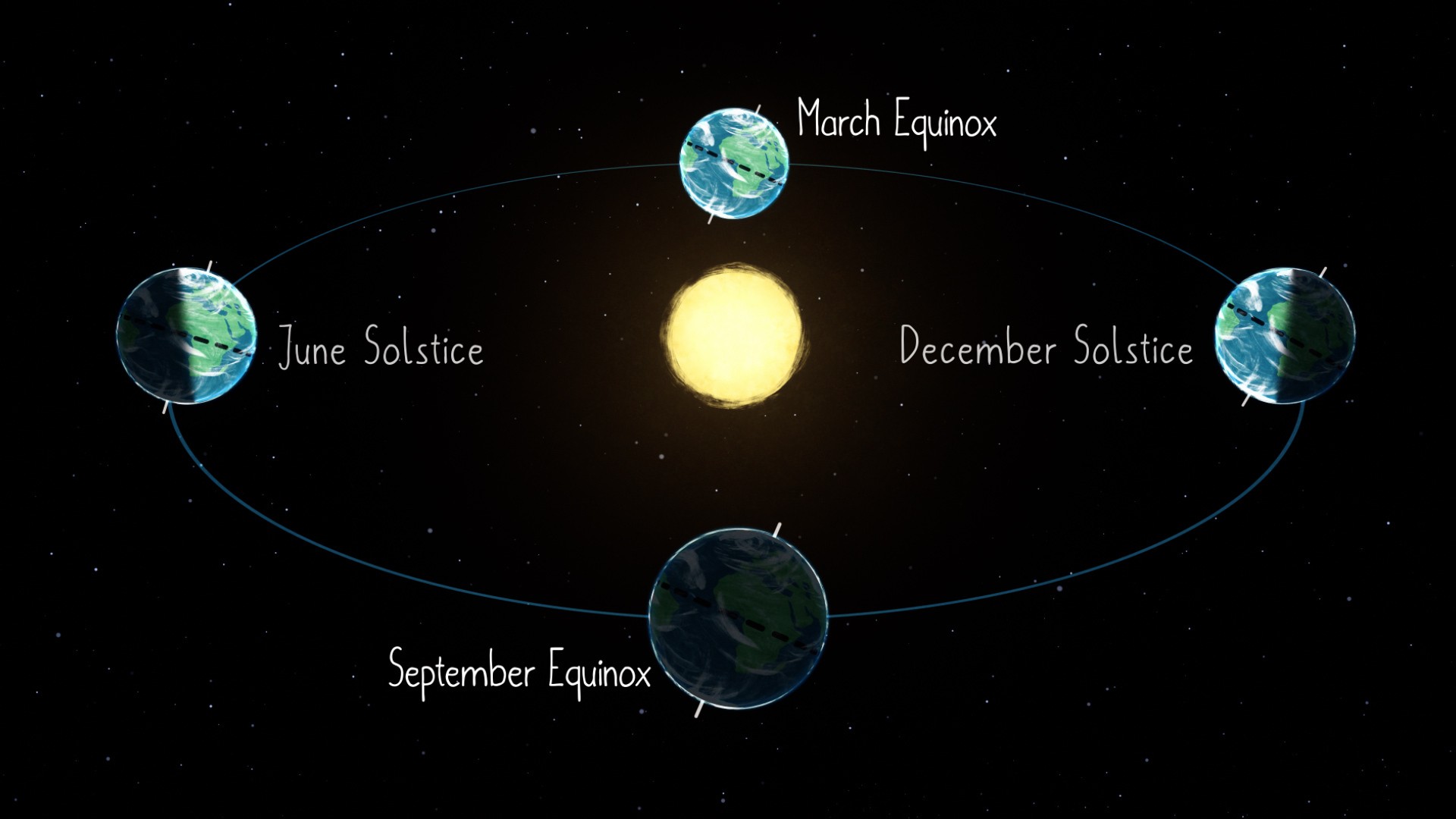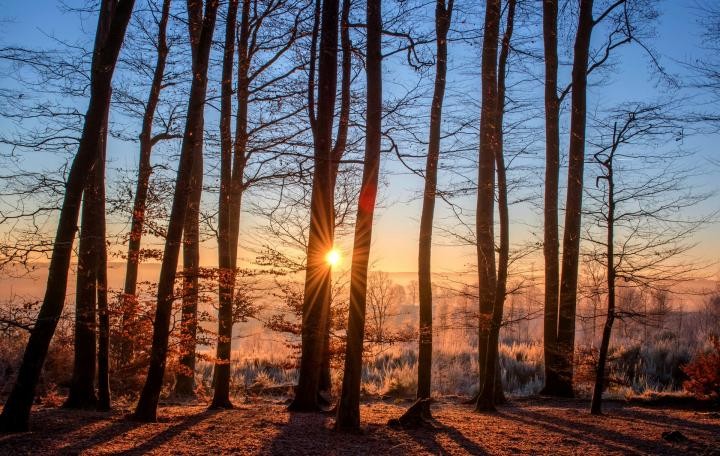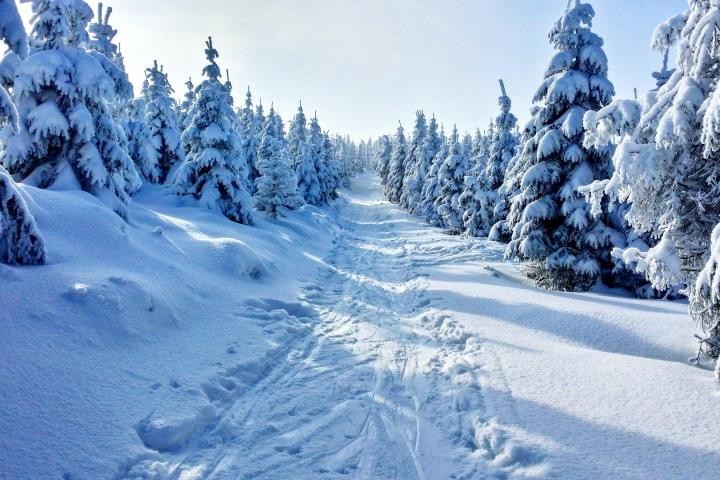The first day of winter, also known as the winter solstice, marks the beginning of astronomical winter and the shortest day of the year. At WHAT.EDU.VN, we provide you with a clear understanding of this celestial event and its cultural significance. Discover the science behind the winter solstice and its impact on our planet. Unlock a deeper appreciation for the changing seasons and celestial events that shape our lives with additional details on winter solstice traditions and astronomical seasons.
1. Understanding the Winter Solstice
The winter solstice, occurring annually around December 21st in the Northern Hemisphere, marks the astronomical beginning of winter. It’s when the North Pole is tilted farthest from the Sun, resulting in the shortest day and longest night of the year. This phenomenon is not just a date on the calendar; it’s a celestial event with profound implications.
1.1. Defining the Winter Solstice
The winter solstice is the precise moment when a hemisphere is tilted farthest away from the sun. This event typically occurs on December 21st or 22nd in the Northern Hemisphere and around June 20th or 21st in the Southern Hemisphere. The term “solstice” comes from the Latin words “sol” (sun) and “sistere” (to stand still), reflecting the sun’s apparent pause in the sky during this time. According to NASA, the Earth’s axial tilt is the primary cause of the solstices.
1.2. Astronomical vs. Meteorological Winter
It’s essential to distinguish between astronomical and meteorological winter. Astronomical winter, as mentioned, begins with the winter solstice. Meteorological winter, on the other hand, is defined by meteorologists and climatologists as the three-month period of December, January, and February in the Northern Hemisphere. This categorization is based on the annual temperature cycle and helps in consistent climate data comparison.
1.3. The Earth’s Tilt and the Seasons
The Earth’s axial tilt of approximately 23.5 degrees is the fundamental reason for the existence of seasons. Throughout the year, different parts of the Earth are tilted towards or away from the Sun, leading to variations in sunlight and temperature. During the winter solstice in the Northern Hemisphere, the North Pole is tilted farthest away, resulting in less direct sunlight and colder temperatures.
The Earth’s axial tilt causes different hemispheres to experience winter and summer solstices at opposite times of the year.
2. Why Does the Winter Solstice Matter?
The winter solstice is more than just a date on the calendar; it has significant astronomical, cultural, and historical importance.
2.1. Astronomical Significance
From an astronomical perspective, the winter solstice marks a turning point in the Earth’s orbit around the Sun. After the solstice, the days gradually begin to lengthen, signaling the return of sunlight and warmer weather in the coming months. This shift has been observed and celebrated by cultures around the world for millennia.
2.2. Cultural and Historical Importance
Across various cultures, the winter solstice has been a time of celebration, reflection, and renewal. Ancient civilizations often associated the solstice with the rebirth of the Sun and the promise of a new year. Many traditions and festivals, such as Yule, Saturnalia, and Dongzhi, have their roots in winter solstice celebrations.
2.3. Impact on Daily Life
The winter solstice affects various aspects of daily life, from agriculture to energy consumption. Farmers traditionally used the solstice to mark the beginning of winter and plan their activities accordingly. In modern times, the solstice can influence energy demand, as people adjust their heating and lighting usage based on the changing daylight hours.
3. When is the First Day of Winter in Upcoming Years?
Here’s a quick look at the winter solstice dates for the next few years:
| Year | Winter Solstice (Northern Hemisphere) |
|---|---|
| 2024 | Saturday, December 21 |
| 2025 | Sunday, December 21 |
| 2026 | Monday, December 21 |
| 2027 | Tuesday, December 21 |
| 2028 | Thursday, December 21 |



Please note that the exact time of the solstice may vary slightly each year.
4. How Different Cultures Celebrate the Winter Solstice
The winter solstice has been celebrated in diverse ways across different cultures throughout history.
4.1. Ancient Traditions
Many ancient civilizations, including the Romans, Celts, and Norse, had unique traditions associated with the winter solstice. The Romans celebrated Saturnalia, a festival honoring the god Saturn, with feasting, gift-giving, and revelry. The Celts observed Yule, a festival marking the rebirth of the Sun, with bonfires and feasts. The Norse celebrated jól, a time of feasting and honoring ancestors.
4.2. Modern Celebrations
Today, many cultures continue to celebrate the winter solstice with various traditions and festivals. In China, the Dongzhi Festival is a time for family gatherings and enjoying traditional foods like tangyuan. In Iran, Shab-e Yalda is celebrated with family gatherings, storytelling, and enjoying fruits and nuts.
4.3. Adaptations and Evolutions
Over time, many winter solstice traditions have evolved and adapted to modern times. Some traditions have been incorporated into other holidays, such as Christmas, while others have been revived and reinterpreted in contemporary contexts.
5. The Science Behind the Shortest Day
The winter solstice is the day with the fewest hours of sunlight, but why does this happen?
5.1. Earth’s Orbit and Axial Tilt
The Earth’s orbit around the Sun is not perfectly circular but slightly elliptical. This means that the distance between the Earth and the Sun varies throughout the year. However, the primary reason for the shortest day is the Earth’s axial tilt. As the North Pole tilts farthest away from the Sun, the Northern Hemisphere receives less direct sunlight, resulting in shorter days and longer nights.
5.2. Angle of Sunlight
During the winter solstice, the angle of sunlight striking the Northern Hemisphere is at its shallowest. This means that the sunlight is spread over a larger area, resulting in less intense heating and lower temperatures.
5.3. Impact on Daylight Hours
The winter solstice marks the point at which the days begin to lengthen again. After the solstice, the amount of daylight gradually increases until the summer solstice, when the days are at their longest.
6. Common Misconceptions About the Winter Solstice
There are several common misconceptions about the winter solstice that need to be addressed.
6.1. Is it the Coldest Day of the Year?
Many people mistakenly believe that the winter solstice is the coldest day of the year. However, this is not always the case. The coldest temperatures typically occur several weeks after the solstice, due to the time it takes for the Earth to cool down.
6.2. Does it Happen on the Same Day Every Year?
While the winter solstice usually occurs on December 21st or 22nd in the Northern Hemisphere, the exact date can vary slightly from year to year. This is due to the Earth’s elliptical orbit and the complexities of the Gregorian calendar.
6.3. Is it a Northern Hemisphere Phenomenon Only?
The winter solstice is not exclusively a Northern Hemisphere phenomenon. While the Northern Hemisphere experiences its winter solstice in December, the Southern Hemisphere experiences its winter solstice in June. At that time, the North Hemisphere experiences summer Solstice, according to Time and Date.
7. Connecting With Nature During the Winter Solstice
The winter solstice is an excellent opportunity to connect with nature and appreciate the beauty of the season.
7.1. Observing the Sunrise and Sunset
One way to connect with nature during the winter solstice is to observe the sunrise and sunset. On the shortest day of the year, the sunrise will be at its latest and the sunset at its earliest. Taking the time to witness these events can be a powerful reminder of the cyclical nature of the seasons.
7.2. Stargazing
The long nights of winter provide excellent opportunities for stargazing. With clear skies and minimal light pollution, you can observe constellations, planets, and other celestial objects.
7.3. Winter Hikes
If you live in an area with snowy landscapes, consider taking a winter hike. Exploring the natural world in its winter guise can be a unique and rewarding experience.
A snowy forest landscape captures the quiet beauty of winter and the sense of reflection it inspires.
8. Winter Solstice FAQs
Here are some frequently asked questions about the winter solstice:
| Question | Answer |
|---|---|
| What is the winter solstice? | The winter solstice marks the astronomical beginning of winter and the shortest day of the year. |
| When does the winter solstice occur? | The winter solstice typically occurs on December 21st or 22nd in the Northern Hemisphere. |
| Why does the winter solstice happen? | The winter solstice is caused by the Earth’s axial tilt and its orbit around the Sun. |
| How do different cultures celebrate the winter solstice? | Cultures around the world celebrate the winter solstice with various traditions and festivals. |
| Is the winter solstice the coldest day of the year? | No, the coldest temperatures typically occur several weeks after the solstice. |
9. Activities to Celebrate the Winter Solstice
There are many ways to celebrate the winter solstice and embrace the spirit of the season.
9.1. Host a Winter Solstice Gathering
Gather your friends and family for a winter solstice celebration. You can share a meal, exchange gifts, and engage in activities that honor the season.
9.2. Create Winter-Themed Crafts
Engage in winter-themed crafts, such as making ornaments, decorating candles, or creating nature-inspired art.
9.3. Reflect on the Past Year
Use the winter solstice as an opportunity to reflect on the past year and set intentions for the new year. You can journal, meditate, or engage in other reflective practices.
10. The Winter Solstice and Climate Change
In recent years, the winter solstice has taken on new significance in the context of climate change.
10.1. Impact of Climate Change on Seasons
Climate change is affecting the seasons, leading to shifts in temperature, precipitation patterns, and the timing of seasonal events. These changes can have significant impacts on ecosystems, agriculture, and human societies.
10.2. Raising Awareness
The winter solstice can be used as a platform to raise awareness about climate change and its effects. By highlighting the connection between the seasons and the Earth’s climate, we can encourage people to take action to mitigate climate change.
10.3. Sustainable Practices
During the winter solstice and throughout the year, we can adopt sustainable practices to reduce our environmental impact. This includes conserving energy, reducing waste, and supporting eco-friendly products and services.
11. How Animals Adapt to the Winter Solstice
Animals have developed various strategies to adapt to the challenges of the winter solstice and the winter season.
11.1. Hibernation
Some animals, such as bears, groundhogs, and bats, hibernate during the winter months to conserve energy. Hibernation is a state of inactivity characterized by lowered body temperature, slowed metabolism, and reduced heart rate and breathing.
11.2. Migration
Other animals, such as birds and butterflies, migrate to warmer regions during the winter to find food and suitable breeding grounds. Migration is a remarkable feat of endurance and navigation.
11.3. Physical Adaptations
Many animals develop physical adaptations to cope with the cold weather. These adaptations can include thicker fur or feathers, increased body fat, and specialized blood circulation to prevent freezing.
Snowy mountain tracks show animal adaptation to winter and human exploration of the season’s landscapes.
12. The Psychological Effects of the Winter Solstice
The winter solstice can have psychological effects on people, particularly those who are sensitive to changes in daylight hours.
12.1. Seasonal Affective Disorder (SAD)
Seasonal Affective Disorder (SAD) is a type of depression that is related to changes in the seasons. SAD typically begins in the fall or winter and lasts until the spring or summer. Symptoms of SAD can include fatigue, sadness, irritability, and difficulty concentrating.
12.2. Coping Strategies
There are several coping strategies that can help people manage the psychological effects of the winter solstice. These strategies can include getting regular exercise, spending time outdoors, using light therapy, and seeking support from friends, family, or a therapist.
12.3. Embracing the Season
Instead of focusing on the negative aspects of winter, try to embrace the season and find joy in winter activities. This can include skiing, snowboarding, ice skating, or simply enjoying a cozy evening by the fire.
13. Winter Solstice in Literature and Art
The winter solstice has been a source of inspiration for artists and writers throughout history.
13.1. Literary References
Many works of literature reference the winter solstice, often using it as a symbol of darkness, renewal, or transformation.
13.2. Artistic Depictions
Artists have depicted the winter solstice in various ways, capturing its beauty, mystery, and spiritual significance.
13.3. Cultural Impact
The winter solstice has had a profound impact on culture, shaping traditions, beliefs, and artistic expression.
14. Looking Ahead: The Return of the Sun
The winter solstice marks the beginning of the return of the Sun. After the shortest day of the year, the days gradually begin to lengthen, bringing more sunlight and warmer weather.
14.1. Symbolism of Hope and Renewal
The return of the Sun is often seen as a symbol of hope and renewal. It represents the triumph of light over darkness and the promise of new beginnings.
14.2. Anticipating Spring
As the days lengthen, we can begin to anticipate the arrival of spring. Spring is a time of rebirth, growth, and renewal, and it brings with it a sense of optimism and excitement.
14.3. Celebrating the Cycle of Seasons
The winter solstice is a reminder of the cyclical nature of the seasons. Each season has its unique qualities and challenges, and by celebrating the cycle of seasons, we can gain a deeper appreciation for the natural world.
15. How to Find More Answers on WHAT.EDU.VN
Are you still curious about the winter solstice or other topics? WHAT.EDU.VN is here to provide you with answers and insights.
15.1. Exploring Our Website
Our website is filled with informative articles, FAQs, and resources on a wide range of subjects. Use our search function to find the information you need.
15.2. Asking Questions
If you can’t find the answer to your question on our website, don’t hesitate to ask us directly. Our team of experts is here to help you explore the world around you.
15.3. Contact Information
You can reach us at:
- Address: 888 Question City Plaza, Seattle, WA 98101, United States
- WhatsApp: +1 (206) 555-7890
- Website: WHAT.EDU.VN
We’re committed to providing you with free, reliable, and accessible information. At WHAT.EDU.VN, we understand the challenges of finding quick and free answers to your questions. You may not know who to ask or where to look, and the cost of consultation can be a concern. That’s why we’ve created a platform that addresses these issues directly.
We offer a free platform to ask any question you have. We strive to answer questions quickly and accurately, providing information that is easy to understand and helpful. We connect you with a community to exchange knowledge and offer free consultation for simple issues.
Don’t let your questions go unanswered. Visit what.edu.vn today and ask your question for free. Let us help you find the answers you’re looking for.
